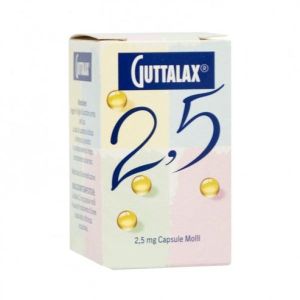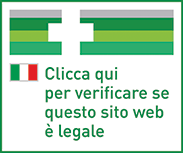Ship in Europe, Find out rates!
Language
Guttalax*30cps Soft 2.5mg

Regular Price
€9.90
Special Price
€9.66
-2%
Save: €0.24
Out of stock
- box Delivery in Italy in 24/48 and free returns
- star3.000+ positive reviews
- dropboxOver 60,000 products in the catalog
Manufacturer
SANOFI
SKU
020949071
Active principle
SODIO PICOSOLFATO
NAME
GUTTALAX 2.5 MG SOFT CAPSULES
PHARMACOTHERAPEUTIC CATEGORY
Contact laxatives.
ACTIVE PRINCIPLES
Sodium picosulfate.
EXCIPIENTS
Macrogol 400, propylene glycol, purified water, gelatin, glycerol.
INDICATIONS
Short-term treatment of occasional constipation.
CONTRAINDICATIONS / SECONDARY EFFECT
Hypersensitivity to the active substance and to any of the listed excipients; paralytic ileus or intestinal or biliary obstruction or stricture; acute severe painful and / or febrile abdominal conditions (such as appendicitis) associated with nausea and vomiting; severe state of dehydration; nausea or vomiting; acute inflammation of the gastrointestinal tract; rectal bleeding of unknown origin; gallstones; liver failure; pregnancy and breastfeeding. Do not administer to children younger 'less than 4 years.
DOSAGE
Adults: 2-3 soft capsules (5-7.5 mg) per day. Children over 10 years: 2-3 soft capsules (5-7.5 mg) per day. Children between 4 and 10 years: 1 soft capsule (2.5 mg) per day. The drug in soft capsules is not recommended for children under 4 years of age. For children younger 'less than 4 years use the medicine in drops. Do not exceed the recommended dose. It is advisable to initially use the minimum doses provided. The correct dose is the minimum sufficient to produce an easy evacuation of soft faeces. When necessary, the dose can then be increased, but without ever exceeding the maximum indicated. The soft capsules should preferably be taken lasera to evacuate the next morning. The soft capsules must be swallowed together with an adequate quantity of water (a large glass). A diet rich in liquids favors the effect of the medicine. Laxatives should be used as infrequently as possible and for no more than seven days. Use for longer periods of time requires a doctor's prescription after adequate evaluation of the individual case.
STORAGE
Store at a temperature not exceeding 30 degrees C.
WARNINGS
The product should not be taken continuously or for long periods of time, without investigating the cause of the constipation. Prolonged and excessive use can 'lead to diarrhea, electrolyte imbalance and hypokalaemia. Cases of dizziness and / or syncope have been reported in patients taking the drug. The available data on these cases suggest that the events could be related to defecation syncope (or syncope attributable to evacuative effort), or to a vasovagal response to abdominal pain related to constipation, and not necessarily to the intake of picosulfate sodium itself. The abuse of laxatives (frequent or prolonged use or with excessive doses) can cause persistent diarrhea with consequent loss of water, mineral salts (especially potassium) and other essential nutritional factors. In the most severe cases the onset of dehydration or hypokalaemia is possible, which can cause cardiac or neuromuscular dysfunction, especially in the case of simultaneous treatment with cardiac glycosides, diuretics or corticosteroids. The abuse of laxatives, especially contact laxatives (stimulant laxatives), can cause addiction (and, therefore, possible need to gradually increase the dosage), chronic constipation and loss of normal intestinal functions (intestinal atony). In children aged between 4 and 12 years, the drug can only be used after medical consultation. For children younger than 4 years use the drug ingocce. The treatment of chronic or recurrent constipation always requires the intervention of the physician for the diagnosis, the prescription of drugs and the surveillance during the course of therapy. Consult your doctor when the need for the laxative derives from a sudden change in previous bowel habits (frequency and characteristics of bowel movements) that has lasted for more than two weeks or when the use of thexative fails to produce effects. It is also advisable that elderly people or those in poor health conditions consult their doctor before using the medicine.
INTERACTIONS
Laxatives can reduce the time spent in the intestine, and therefore the absorption, of other drugs administered simultaneously orally. Therefore, avoid ingesting laxatives and other drugs at the same time: after taking a medicine, leave an interval of at least 2 hours before taking the laxative. Milk or antacids can change the effect of the medicine; leave an interval of at least an hour before taking the laxative. Continued use of the drug may increase patient response to oral anticoagulants and change tolerance to glucose. The concomitant intake of diuretics or adrenocorticosteroids and excessive doses of the drug can 'lead to an increased risk of electrolyte imbalance. This imbalance, in turn, can lead to an increase in sensitivity to cardioactive glycosides. The concomitant administration of antibiotics can reduce the laxative effect of the drug.
SIDE EFFECTS
The medicine can cause side effects, although not everybody gets them. Adverse reactions are listed below by system organ class and frequency, according to the following categories: very common> = 1/10; common> = 1/100, <1/10; uncommon> = 1 / 1,000, <1/100; rare> = 1 / 10,000, <1 / 1,000; very rare <1 / 10,000; not known. Disorders of the immune system. Not known: hypersensitivity '. Nervous system disorders. Uncommon: dizziness; not known: syncope. The phenomena of dizziness and syncope that occur after the intake of sodium picosulfate seem to be attributable to a vasovagal response (resulting, for example, from abdominal pain or stool evacuation). Gastrointestinal disorders. Very common: diarrhea; common: abdominal cramps, abdominal pain and abdominal discomfort; uncommon: vomiting, nausea. Occasionally: isolated cramping pains or abdominal colic, more frequent in cases of severe constipation. Skin and subcutaneous tissue disorders. Not known: skin reactions such as angioedema, rash on taking the medicine, rash, pruritus. By reporting side effects you can help provide more information on the safety of this medicine.
PREGNANCY AND BREASTFEEDING
No studies have been conducted to evaluate the effects on human fertility. Non-clinical studies did not reveal any effect on fertility. There are no adequate and well-controlled studies on the use of the drug in pregnancy. Long experience has shown no evidence of unwanted or harmful effects during pregnancy. Although no toxic effects have ever been reported during pregnancy, the drug should only be used in case of need, after evaluating the expected benefit for the mother in relation to the possible risk for the fetus. Clinical data show that neither the active fraction of sodium picosulfate, bis- (p-hydroxyphenyl) -pyridyl-2-methane (BHPM), nor the conjugated form (its glucuronic derivatives), are excreted, in determinable quantities in breast milk. . However, the medicine should be used only in case of need ', after evaluating the expected benefit for the mother in relation to the possible risk for the infant.
GUTTALAX 2.5 MG SOFT CAPSULES
PHARMACOTHERAPEUTIC CATEGORY
Contact laxatives.
ACTIVE PRINCIPLES
Sodium picosulfate.
EXCIPIENTS
Macrogol 400, propylene glycol, purified water, gelatin, glycerol.
INDICATIONS
Short-term treatment of occasional constipation.
CONTRAINDICATIONS / SECONDARY EFFECT
Hypersensitivity to the active substance and to any of the listed excipients; paralytic ileus or intestinal or biliary obstruction or stricture; acute severe painful and / or febrile abdominal conditions (such as appendicitis) associated with nausea and vomiting; severe state of dehydration; nausea or vomiting; acute inflammation of the gastrointestinal tract; rectal bleeding of unknown origin; gallstones; liver failure; pregnancy and breastfeeding. Do not administer to children younger 'less than 4 years.
DOSAGE
Adults: 2-3 soft capsules (5-7.5 mg) per day. Children over 10 years: 2-3 soft capsules (5-7.5 mg) per day. Children between 4 and 10 years: 1 soft capsule (2.5 mg) per day. The drug in soft capsules is not recommended for children under 4 years of age. For children younger 'less than 4 years use the medicine in drops. Do not exceed the recommended dose. It is advisable to initially use the minimum doses provided. The correct dose is the minimum sufficient to produce an easy evacuation of soft faeces. When necessary, the dose can then be increased, but without ever exceeding the maximum indicated. The soft capsules should preferably be taken lasera to evacuate the next morning. The soft capsules must be swallowed together with an adequate quantity of water (a large glass). A diet rich in liquids favors the effect of the medicine. Laxatives should be used as infrequently as possible and for no more than seven days. Use for longer periods of time requires a doctor's prescription after adequate evaluation of the individual case.
STORAGE
Store at a temperature not exceeding 30 degrees C.
WARNINGS
The product should not be taken continuously or for long periods of time, without investigating the cause of the constipation. Prolonged and excessive use can 'lead to diarrhea, electrolyte imbalance and hypokalaemia. Cases of dizziness and / or syncope have been reported in patients taking the drug. The available data on these cases suggest that the events could be related to defecation syncope (or syncope attributable to evacuative effort), or to a vasovagal response to abdominal pain related to constipation, and not necessarily to the intake of picosulfate sodium itself. The abuse of laxatives (frequent or prolonged use or with excessive doses) can cause persistent diarrhea with consequent loss of water, mineral salts (especially potassium) and other essential nutritional factors. In the most severe cases the onset of dehydration or hypokalaemia is possible, which can cause cardiac or neuromuscular dysfunction, especially in the case of simultaneous treatment with cardiac glycosides, diuretics or corticosteroids. The abuse of laxatives, especially contact laxatives (stimulant laxatives), can cause addiction (and, therefore, possible need to gradually increase the dosage), chronic constipation and loss of normal intestinal functions (intestinal atony). In children aged between 4 and 12 years, the drug can only be used after medical consultation. For children younger than 4 years use the drug ingocce. The treatment of chronic or recurrent constipation always requires the intervention of the physician for the diagnosis, the prescription of drugs and the surveillance during the course of therapy. Consult your doctor when the need for the laxative derives from a sudden change in previous bowel habits (frequency and characteristics of bowel movements) that has lasted for more than two weeks or when the use of thexative fails to produce effects. It is also advisable that elderly people or those in poor health conditions consult their doctor before using the medicine.
INTERACTIONS
Laxatives can reduce the time spent in the intestine, and therefore the absorption, of other drugs administered simultaneously orally. Therefore, avoid ingesting laxatives and other drugs at the same time: after taking a medicine, leave an interval of at least 2 hours before taking the laxative. Milk or antacids can change the effect of the medicine; leave an interval of at least an hour before taking the laxative. Continued use of the drug may increase patient response to oral anticoagulants and change tolerance to glucose. The concomitant intake of diuretics or adrenocorticosteroids and excessive doses of the drug can 'lead to an increased risk of electrolyte imbalance. This imbalance, in turn, can lead to an increase in sensitivity to cardioactive glycosides. The concomitant administration of antibiotics can reduce the laxative effect of the drug.
SIDE EFFECTS
The medicine can cause side effects, although not everybody gets them. Adverse reactions are listed below by system organ class and frequency, according to the following categories: very common> = 1/10; common> = 1/100, <1/10; uncommon> = 1 / 1,000, <1/100; rare> = 1 / 10,000, <1 / 1,000; very rare <1 / 10,000; not known. Disorders of the immune system. Not known: hypersensitivity '. Nervous system disorders. Uncommon: dizziness; not known: syncope. The phenomena of dizziness and syncope that occur after the intake of sodium picosulfate seem to be attributable to a vasovagal response (resulting, for example, from abdominal pain or stool evacuation). Gastrointestinal disorders. Very common: diarrhea; common: abdominal cramps, abdominal pain and abdominal discomfort; uncommon: vomiting, nausea. Occasionally: isolated cramping pains or abdominal colic, more frequent in cases of severe constipation. Skin and subcutaneous tissue disorders. Not known: skin reactions such as angioedema, rash on taking the medicine, rash, pruritus. By reporting side effects you can help provide more information on the safety of this medicine.
PREGNANCY AND BREASTFEEDING
No studies have been conducted to evaluate the effects on human fertility. Non-clinical studies did not reveal any effect on fertility. There are no adequate and well-controlled studies on the use of the drug in pregnancy. Long experience has shown no evidence of unwanted or harmful effects during pregnancy. Although no toxic effects have ever been reported during pregnancy, the drug should only be used in case of need, after evaluating the expected benefit for the mother in relation to the possible risk for the fetus. Clinical data show that neither the active fraction of sodium picosulfate, bis- (p-hydroxyphenyl) -pyridyl-2-methane (BHPM), nor the conjugated form (its glucuronic derivatives), are excreted, in determinable quantities in breast milk. . However, the medicine should be used only in case of need ', after evaluating the expected benefit for the mother in relation to the possible risk for the infant.


